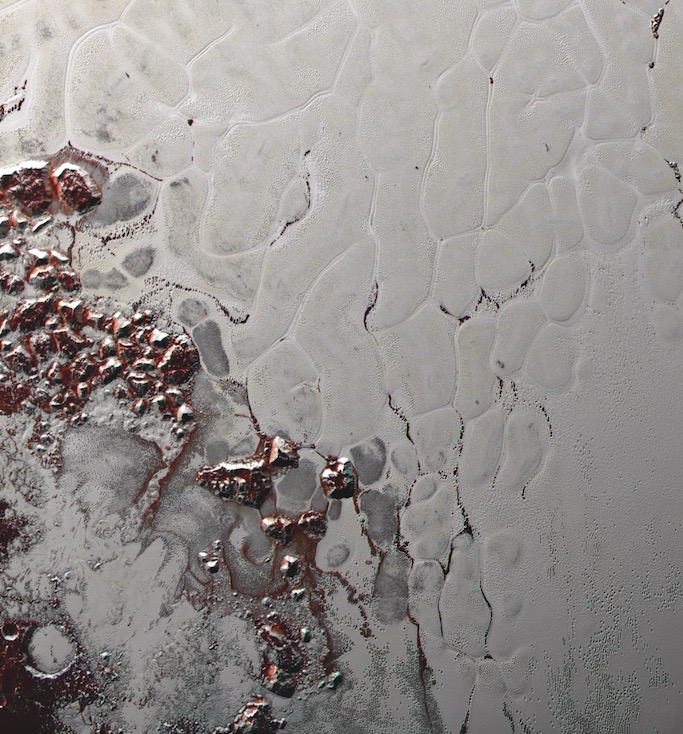Pluto's Heavy Heart Shaped Dwarf Planet's Landscape

Pluto's famous heart may not have been born in violence after all.
Researchers have generally assumed that the heart's left "lobe" — a 600-mile-wide (1,000 kilometers) plain called Sputnik Planitia (formerly Sputnik Planum) — is an enormous impact crater that subsequently filled with frozen nitrogen and other exotic ices.
But a new study suggests that the ice buildup came first and the accumulated material eventually pushed the underlying landscape down, much as Greenland's enormous ice sheet has done here on Earth. [See more awesome close-up photos of Pluto]
"Pluto's big heart weighs heavily on the small planet, leading inevitably to depression," study lead author Douglas Hamilton, a professor of astronomy at the University of Maryland, said in a statement.
It's no accident that Sputnik Planitia — which was discovered by NASA's New Horizons probe during its epic Pluto flyby in July 2015 — is centered at 25 degrees north, Hamilton said. His team's computer models predicted that ice would accumulate at about 30 degrees north or south latitude, because these are the coldest regions on Pluto. (The dwarf planet is tilted roughly 120 degrees relative to its orbital plane, compared with 23 degrees for Earth.)
"The poles on Pluto, averaged over a year, are actually the hottest parts of the planet, not the coldest," Hamilton told Space.com, referring to one Pluto year, which lasts 248 Earth years. "That's alien to us and sounds wrong, but math doesn't lie. That's how it works out."
In addition, the group's simulations indicated that ice wouldn't build up in a band at 30 degrees north and/or south. Rather, a single ice cap would form, as the result of a (nearly literal) snowball effect: As ices started to accumulate in one spot, that area would reflect more sunlight and thus become colder than surrounding regions, leading to greater ice deposition, and so on.
Breaking space news, the latest updates on rocket launches, skywatching events and more!
Previous studies based on New Horizons data suggest that Sputnik Planitia's ice is at least 1.2 to 1.8 miles (2 to 3 km) thick (and possibly much thicker). So, at a minimum, 0.03 percent of Pluto's entire mass is concentrated in the ice cap, Hamilton said. That's enough material to push the landscape down and form a huge basin, he added.
The team's models further indicate that ice accumulation in Sputnik Planitia happened quickly. The cap likely formed within a million years of the giant impact on Pluto that formed the dwarf planet's largest moon, Charon, and has been relatively stable since, researchers said. (Exactly when the Charon-forming impact occurred is unknown, but it was probably quite early in the solar system's history.)
After Charon's birth, Pluto's rotation slowed until the two bodies were "tidally locked," showing each other only one face, as Earth's moon shows just one side to us. According to the researchers' simulations, Charon's gravitational tug then pulled Sputnik Planitia into its current alignment opposite the moon.
In short, the team's modeling results explain pretty well what New Horizons saw on July 14, 2015, Hamilton said.
Indeed, given any starting conditions on Pluto, those simulations produce an ice cap sitting in a basin in one of four spots, Hamilton said — at about 30 degrees north or south, and either facing toward or away from Charon.
This scenario provides a "simpler" explanation for Sputnik Planitia than the prevailing view, which posits that the basin formed after a cosmic impact, study team members said.
"This interpretation has the advantage of providing an explanation for why the basin is coincident with the ice cap and why both are located at the coldest latitude on Pluto and at a longitude that is directly opposite Charon," Hamilton and his colleagues wrote in the new study, which was published online today (Nov. 30) in the journal Nature.
Other researchers have modeled the formation and evolution of Sputnik Planitia as well, but these efforts have tended to assume that the basin is an ancient impact feature. One such team, led by Francis Nimmo of the University of California, Santa Cruz, recently concluded that the position of Sputnik Planitia hints at the presence of a subsurface ocean on Pluto, a possibility raised by several other lines of evidence as well.
The new study has little bearing on this question, said Hamilton, who was also a co-author on the Nimmo-led paper.
"My modeling doesn't care too much one way or the other about whether there's an ocean," Hamilton told Space.com.
Definitively figuring out whether Pluto harbors a buried ocean may require launching an orbiter to the dwarf planet, he added.
Follow Mike Wall on Twitter @michaeldwall and Google+. Follow us @Spacedotcom, Facebook or Google+. Originally published on Space.com.

Michael Wall is a Senior Space Writer with Space.com and joined the team in 2010. He primarily covers exoplanets, spaceflight and military space, but has been known to dabble in the space art beat. His book about the search for alien life, "Out There," was published on Nov. 13, 2018. Before becoming a science writer, Michael worked as a herpetologist and wildlife biologist. He has a Ph.D. in evolutionary biology from the University of Sydney, Australia, a bachelor's degree from the University of Arizona, and a graduate certificate in science writing from the University of California, Santa Cruz. To find out what his latest project is, you can follow Michael on Twitter.

